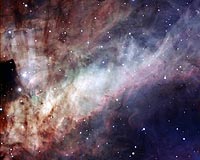 |
Science@NASA Huntsville AL (SPX) Jul 10, 2009 On June 29th, neighbors of Paul Mortfield in Ontario, Canada, heard "cheers of excitement" coming from the astronomer's house. What caused the commotion? "I had just observed NASA's LCROSS spacecraft," explains Mortfield. Using no more than a backyard telescope, he caught it zipping past spiral galaxy IC3808. LCROSS is the Lunar Crater Observation and Sensing Satellite. It left Earth June 18th atop an Atlas V rocket on a mission to crash into the Moon. On Oct. 9th, NASA plans to plunge LCROSS headfirst into a deep crater near the Moon's south pole. Researchers hope the debris it kicks up will reveal water and other minerals of use to future lunar explorers. Meanwhile, LCROSS is circling the Earth-moon system in a long looping orbit, and NASA is inviting amateur astronomers to help track it. "The more eyes the better," says Brian Day of NASA's Ames Research Center. "We've got to crash this spacecraft into the bottom of a pitch-black crater a quarter of a million miles away with pinpoint accuracy. Amateur astronomers [can help us] precisely determine the position of LCROSS in flight." Typically, LCROSS is in contact with the busy Deep Space Network once every three days, which meets all mission requirements. Amateurs can fill in the gaps by observing LCROSS every day. "During flight, you want to have as many eyes as possible on your spacecraft," notes Day, "not only for tracking, but also in case there is an anomaly. In the past, amateurs have been able to capture venting of materials from shuttles and other spacecraft." Paul Mortfield had little trouble pinpointing LCROSS: "I was quite surprised at how easy it was to find and follow using my 16-inch telescope. I didn't know what brightness to expect or even if it would be where the ephemeris predicted-but there it was. I saw it in my first 60 second exposure." "There were definitely cheers of excitement around the house when I saw it on the computer screen." Mortfield estimates the brightness of the spacecraft to be 16th magnitude, similar to that of many near-Earth asteroids. To find it, he recommends pointing your web browser at JPL's online Horizons ephemeris system (link) and entering 'LCROSS' as the target body. The program will generate a set of coordinates you can plug into the tracking system of almost any modern backyard telescope. "Today's technology is truly amazing, allowing amateurs to capture images far beyond what professionals were doing just a couple of decades ago," says Mortfield. Indeed, says Day, LCROSS is a fairly easy target for experienced amateurs, and he'd love nothing better than to recruit hundreds of observers to keep track of LCROSS in the months ahead. How does an astronomer get started? "Go to the LCROSS observer's group (link). Start reading the articles and chatting with other observers," he suggests. The really big event comes in October when LCROSS crashes into the Moon. Amateur astronomers will be able to observe that, too. Stay tuned for impact observing tips, coming soon from Science@NASA. Share This Article With Planet Earth
Related Links Science@NASA LCROSS Home Page Astronomy News from Skynightly.com
 New Portrait Of Omega Nebula's Glistening Watercolours
New Portrait Of Omega Nebula's Glistening WatercoloursParis, France (SPX) Jul 09, 2009 The Omega Nebula, sometimes called the Swan Nebula, is a dazzling stellar nursery located about 5500 light-years away towards the constellation of Sagittarius (the Archer). An active star-forming region of gas and dust about 15 light-years across, the nebula has recently spawned a cluster of massive, hot stars. The intense light and strong winds from these hulking infants have carved ... read more |
|
| The content herein, unless otherwise known to be public domain, are Copyright 1995-2009 - SpaceDaily. AFP and UPI Wire Stories are copyright Agence France-Presse and United Press International. ESA Portal Reports are copyright European Space Agency. All NASA sourced material is public domain. Additional copyrights may apply in whole or part to other bona fide parties. Advertising does not imply endorsement,agreement or approval of any opinions, statements or information provided by SpaceDaily on any Web page published or hosted by SpaceDaily. Privacy Statement |